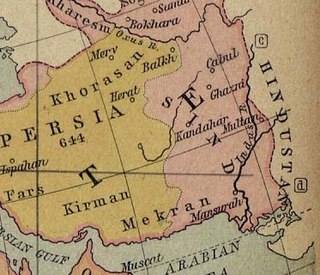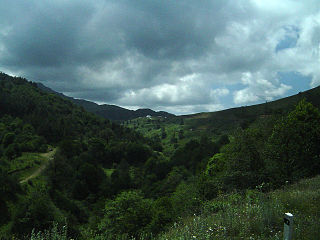
Babur was the founder of the Mughal Empire in the Indian subcontinent. He was a descendant of Timur and Genghis Khan through his father and mother respectively. He was also given the posthumous name of Firdaws Makani.

Muhammad Shaybani Khan was an Uzbek leader who consolidated various Uzbek tribes and laid the foundations for their ascendance in Transoxiana and the establishment of the Khanate of Bukhara. He was a Shaybanid or descendant of Shiban, the fifth son of Jochi, Genghis Khan's eldest son. He was the son of Shah-Budag, thus a grandson of the Uzbek conqueror Abu'l-Khayr Khan.
Qasim bin Janibek Khan, known by his shortened regal name as Qasim Khan was a son of Janibek Khan. He ruled as the fourth Khan of the Kazakh Khanate from about 1511 to 1521. He is viewed as the greatest leader to unite the Kazakh tribes. Although, Burunduk Khan was the Khan of the Kazakhs, the control of the government was in the hands of Qasim Khan. Eventually, he sent Burunduk Khan into exile who died in Samarkand. Qasim Khan had a brother named Adik Khan who was married to Sultana Nigar Khanim, daughter of Yunus Khan of Moghulistan. When Adik Khan died, Qasim Khan took her as his wife.

Sultan Husayn Bayqara Mirza was the Timurid ruler of Herat from 1469 until May 4, 1506, with a brief interruption in 1470.

The Uzbek Khanate, also known as the Abulkhair Khanate was a Shaybanid state preceding the Khanate of Bukhara. During the few years it existed, the Uzbek Khanate was the preeminent state in Central Asia, ruling over most of modern-day Uzbekistan, much of Kazakhstan and Turkmenistan, and parts of southern Russia. This is the first state of the Abulkhairids, a branch of the Shaybanids.

The Khanate of Bukhara was an Uzbek state in Central Asia from 1501 to 1785, founded by the Abu'l-Khayrid dynasty, a branch of the Shaybanids. From 1533 to 1540, Bukhara briefly became its capital during the reign of Ubaydallah Khan. The Khanate reached its greatest extent and influence under its penultimate Abu'l-Khayrid ruler, the scholarly Abdullah Khan II.
The Battle of Ghazdewan occurred near the city of Ghijduvan, what is now Uzbekistan in November 1512 AD between Safavid army and Uzbek army.
In May 1497 the two armies of Babur and Sultan Ali successfully besieged and captured the city of Samarkand.

In 1504, Babur besieged Kabul and took the city from the Arghuns under Mukim Beg Arghun, to become the new king of Kabul and Ghazni regions. The territory gave him respite from his Uzbek troubles in Central Asia. It allowed him to build his nascent kingdom into a strong and formidable power in later years, enough to conquer northern India.

After the death of King Abu Sa'id Mirza, the great-grandson of Amir Timur Beg Gurkani, his much reduced Timurid Empire was divided among four of his sons namely;

In the early 16th century, Sultan Mahmud Khan, the Chagatai Khan of Western Moghulistan, and Sultan Ahmad Alaq Khan, the Chagatai Khan of Eastern Moghulistan, decided to counter the growing power of the Uzbeks under Muhammad Shaybani. Sultan Ahmed Tambol had rebelled against his Timurid master Babur and declared his independence. But when Babur tried to reconquer his territory with the help of his uncles, Ahmed Tambol sought the assistance of the Uzbeks. The two Moghul brothers united their forces and launched a campaign against Tambol, but Muhammad Shaybani surprised the Khans and proved victorious in battle of Akhsi and took them both prisoner.

After the Uzbeks were driven out of Samarkand in early 1501 CE, they regrouped in Bukhara. Muhammad Shaybani began to prepare for another attempt to take Samarkand in April - May 1501 CE. Babur, the Timurid leader, decided to meet this threat before it arrived at the city. The two armies met at Sar-e-Pul, where a decisive battle was fought which decided the fate of the Timurids and of the region, resulting in gradual conquest of Transoxiana, Khwarezm and Khorasan by the Uzbeks.
Badi' al-Zaman Mirza was a Timurid ruler of Herat from 1506 to 1507. He was the son of Husayn Bayqarah, who was a great-great-grandson of Timur.
Sultan Ahmed Mirza was the eldest son of Abu Sa'id Mirza on whose death he became the Timurid ruler of Samarkand and Bukhara from 1469 until 1494. During his rule, he successfully repelled at least one invasion attempt by the Kara Koyunlu, and failed in an attempt to conquer Khurasan from its ruler Sultan Husayn Mirza Bayqara. He was embroiled in the Timurid Civil Wars with his brothers Umar Shaikh Mirza II and Sultan Mahmud Mirza. He died while returning from his Ferghana expedition against Babur, the twelve-year-old son and successor of Umar Shaikh Mirza II. As he had no male heir, he was succeeded by his brother, Sultan Mahmud Mirza.

The Battle of the Chirciq River was fought between Sultan Mahmud Khan of Moghulistan and Sultan Ahmed Mirza, the Timurid ruler of Samarkand & Bukhara in 1488 CE over the city of Tashkent. The Moghuls decisively defeated the Timurids as a result of the defection of 3,000 Uzbeks under the command of Muhammad Shaybani Khan.

The Battle of Qarabagh was fought on February 4, 1469, between Aq Qoyunlu under Uzun Hasan, and the Timurids of Samarkand under Abu Sa'id Mirza, resulting in the latter's defeat, imprisonment and execution. After the battle, the Timurids forever lost any hopes of gaining Iraq or Iran back into their kingdom.

Abul-Qasim Babur Mirza, a Timurid ruler in Khorasan, invaded other parts of the region in the winter of 1448–1449 that were held by the Timurids of Samarkand, led by Ulugh Beg. Abdul-Qasim Babur Mirza was victorious and ruled over the area until his death in 1457.

Khanzada Begum was a Timurid princess and the eldest daughter of Umar Shaikh Mirza II, the amir of Ferghana. She was also the elder sister of Babur, the founder of the Mughal Empire. She and her brother remained deeply attached to each other all their lives, a period during which the family progressed from ruling a tiny and obscure principality in Central Asia to ruling a large portion of the Indian subcontinent. Babur conferred on his sister, the honorable title of Padshah Begum and she was really the first lady of his Empire after his death.
Sultan Mahmud Mirza was a prince of Timurid branch of Transoxiana, son of Abu Sa'id Mirza.
The Kazakh War of Independence (1468–1500) was a conflict fought in Central Asia between the Kazakh Khanate and the Uzbek Khanate, which attempted to maintain its control over most of modern-day Kazakhstan, which at the time was under Uzbek rule. The war started after Abu'l-Khayr, Khan of the Uzbek Khanate, attacked Zhetysu in 1468 which was controlled by a small band of rebel Kazakhs who had split from the original Uzbek Khanate. Abu’l Khayr did so in an attempt to prevent the growing Kazakh influence among the steppe. However, he died unknowingly, making it easier for the Kazakhs to expand their influence. After Abu'l-Khayr Khan's death, the Uzbeks continued to be ruled by the Shaybanids who fought against the Kazakhs in the cities that were on the Syr Darya until both sides agreed to peace in 1500 with the Kazakh Khanate gaining its sovereignty from the Uzbek control. At the end of the war, the Uzbek Khanate transferred most of Kazakhstan to the Kazakh Khanate.












